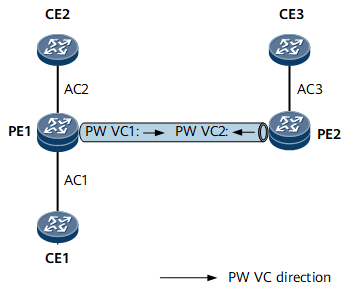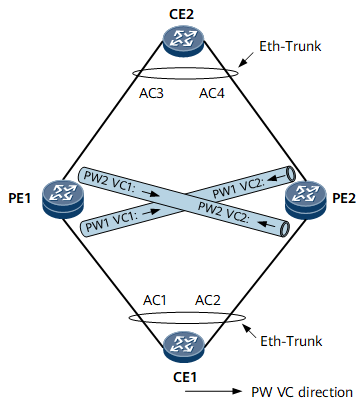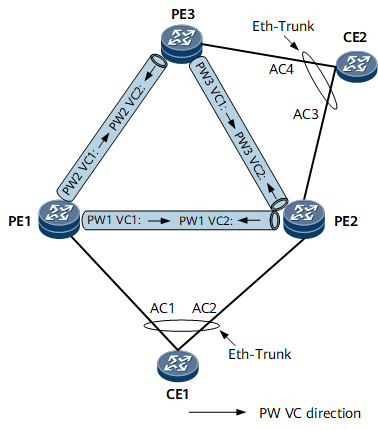Mutual Protection Between an LDP VC and a CCC VC
The use of Layer 2 virtual private network (L2VPN) technologies increases reliability requirements for L2VPNs. This is especially true of L2VPNs that provide real-time services such as VoIP and Internet Protocol television (IPTV).
Configuring mutual protection between a Label Distribution Protocol (LDP) virtual channel (VC) and a circuit cross connect (CCC) VC can meet these requirements. A CCC VC and an LDP VC work in the active/standby mode to protect traffic over each other. If an active path goes Down, traffic is switched to the standby path, therefore improving CCC VC's and LDP VC's reliability.
Single-Homing 2PE Scenario
- CE1 is single-homed to PE1 through AC1 and preferentially accesses CE2 through AC2.
- A PW is established between PE1 and PE2, with PW AC1 protecting traffic transmitted through AC2.
If AC2 fails, CE1 accesses CE3 through the path CE1->AC1->PW VC1->AC3->CE3.
- For AC1->AC2 traffic, the PW functions as the standby path of AC2.
- The path AC2->AC1 does not have a standby path.
- The path AC3->PW VC1 does not have a standby path.
CE2 and CE3 are the active and standby devices respectively in the preceding illustration. In that case, an LDP VC (PW VC1) protects traffic transmitted through a CCC VC (AC2). In real-time deployment, CE3 and CE2 may be the active and standby devices, respectively. In this case, a CCC VC (AC2) protects traffic transmitted through an LDP VC (PW VC1). The configuration roadmap is the same in both cases, so the roadmap for configuring a CCC VC to protect an LDP VC is not described here.
Fault Point |
Switchover |
|---|---|
AC2 or CE2 failure when:
In this case, an LDP VC protects a CCC VC. |
|
PE2, AC3, CE3, or PW failure when:
In this case, a CCC VC protects an LDP VC. |
|
Dual-Homing 2PE Scenario
- CE1 is dual-homed to PE1 and PE2 through an Eth-Trunk, with AC1 serving as the active path.
- CE2 is dual-homed to PE1 and PE2 through another Eth-Trunk, with AC3 serving as the active path.
- PW1 VC1 is deployed between PE1 and PE2 to protect AC3. If AC3 fails, CE1 accesses CE2 through the PW1 VC1->AC4 path.
- PW2 VC1 is deployed between PE1 and PE2 to protect AC1. If AC1 fails, CE2 accesses CE1 through the PW2 VC1->AC2 path.
Based on the preceding, CE1 and CE2 select AC1 and AC3 as the active paths, respectively. They select AC2 and AC4 as the standby paths, respectively. If the active paths fail, the standby paths take over service traffic.
- For AC1->AC3 traffic, configure PW1 VC1 on the AC1 interface to protect AC3.
- For AC2->PW2 VC2 traffic, configure PW2 VC2 on the AC2 interface to protect AC4.
- For AC3->AC1 traffic, configure PW2 VC1 on the AC3 interface to protect AC1.
- For AC4->PW1 VC2 traffic, configure PW1 VC2 on the AC4 interface to protect AC2.
Fault Point |
Switchover |
|---|---|
AC1 fails. |
|
AC3 fails. |
|
PE1 fails. |
|
Dual-Homing 3PE Scenario
- CE1 is dual-homed to PE1 and PE2 through an Eth-Trunk. AC1 serves as the active path, and AC2 serves as the standby path.
- CE2 is dual-homed to PE2 and PE3 through another Eth-Trunk. AC3 serves as the active path, and AC4 serves as the standby path.
- PW redundancy in Independent mode is configured on PE1, with PW1 VC1 being the active PW and PW2 VC1 being the standby PW.
- PW redundancy in Independent mode is configured on PE3, with PW2 VC2 being the active PW and PW3 VC1 being the standby PW.
The PW1 VC1 (active) and PW2 VC1 (standby) paths can be used to transmit traffic from AC1 to CE2. The AC3 (active) and PW3 VC2 (standby) paths can be used to transmit traffic from AC2 to CE2.
- AC1 and AC3 serve as the active paths, and AC2 and AC4 serve as
the standby paths:
- For AC1->PW1 VC1 traffic, configure PW redundancy on the AC1 interface, with PW1 VC1 being the active path and PW2 VC1 being the standby path.
- For AC2->AC3 traffic, configure PW3 VC2 on the AC2 interface to protect AC3.
- For AC3->PW1 VC2 traffic, configure PW1 VC2 on the AC3 interface to protect AC2.
- For AC4->PW2 VC2 traffic, configure PW redundancy on the AC4 interface, with PW2 VC2 being the active path and PW3 VC1 being the standby path.
- AC2 and AC3 serve as the active paths, and AC1 and AC4 serve as
the standby paths:
- For AC1->PW1 VC1 traffic, configure PW redundancy on the AC1 interface, with PW1 VC1 being the active path and PW2 VC1 being the standby path.
- For AC2->AC3 traffic, configure PW3 VC2 on the AC2 interface to protect AC3.
- For AC3->AC2 traffic, configure PW1 VC2 on the AC3 interface to protect AC2.
- For AC4->PW3 VC1 traffic, configure PW redundancy on the AC4 interface, with PW2 VC2 being the active path and PW3 VC1 being the standby path.
Fault Point |
Switchover |
|---|---|
AC3 failure when:
|
|
AC1 failure when:
|
|
AC3 failure when:
|
|
PE2 failure when:
|
|


